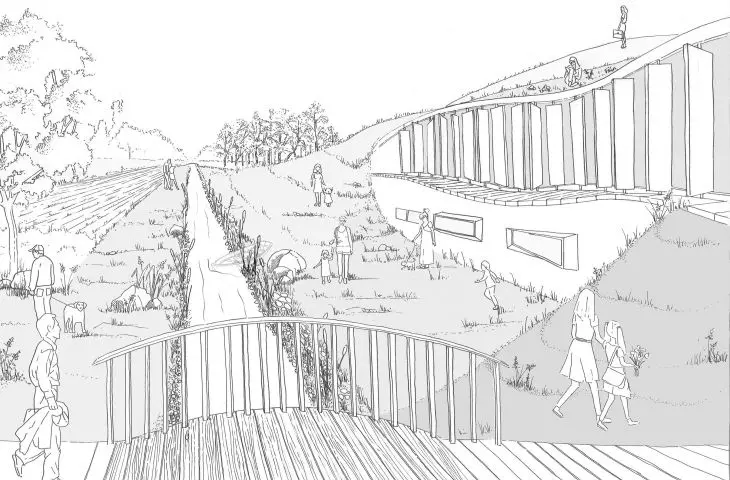{tag:studenci} from the Faculty of Architecture at the Silesian University of Technology was recognized in the international competition "ArchiDots Award for excellence in Architectural Design 2021-22". Her semester project "Hilly Kindergarten" - an atypical kindergarten with a meadow on the roof - received First Prize in the sophomore category.
"ArchiDots Award for excellence in Architectural Design 2021-22" is an international competition for architecture students held in India. The purpose of the competition was to show the potential and appreciate the semester projects internationally, not only the domestic universities. Evaluation of the project depended on three aspects: concept/inspiration, graphic representation/aesthetics and technical drawings.
"Hilly Kindergarten" project, bird's eye view
© Anna Król
First Prize for a student of the Silesian University of Technology
The results were announced in mid-October this year, and awards were given in four categories: freshman, sophomore, junior and senior. The submitted projects were shaded by a jury consisting of Biswajit Sengupta (former member of the IIT Kharagpur Architecture Council Committee), Ritu Nangia (director of Rudraa Associates MIT), Deben Moza (executive director, Knight Frank).
In thesophomore category (sophomore category), the First Prize of 4 thousand rupees and publication on the ArchiDots portal was awarded to Anna Król from the Faculty of Architecture, Silesian University of Technology. Her project "Hilly Kindergarten" was created under the supervision of Dr. Jerzy Wojewódka as part of the subject "Architecture of primary service facilities" during the fourth semester of studies. The instructor of the subject was Dr. Zbyszko Bujniewicz.
The roof of the kindergarten is overgrown with meadow
© Anna Król
"kindergarten with a hill"
The main idea of the award-winning student was to create a place friendly to all its users - children, residents, as well as visitors. The concept preserves the existing meadow on the plot, so that the view from the windows of the surrounding houses does not change much, and gains an attractive recreational space.
"Hilly Kindergarten" project, axonometry
© Anna Król
My Kindergarten breaks the image of a typical children's facility by showing a different approach to its young users. The interior of the building is guided by the concept of a "small city for small people," which children are. Following this idea, I created such spaces as a small amphitheater and recreational and leisure areas in the spaces between the classrooms. I envisioned separate themed rooms so that each day a child can choose his or her own educational path, and each day can be full of new experiences and learning. This also allows the children to make their own individual decisions," explains the author.
The themedrooms designed by the student develop: creativity, sensitivity to nature and art, concentration (tranquility) and physical activity. The playground is an enclosed, partially covered space located in the internal structure of the building. The glazed playground, like the other rooms, illuminates the communication spaces.
© Anna Król
Viewing path and meadow on the roof
The lump of the kindergarten building is covered with earth and illuminated by side and top glazing. Thanks to the use of heat buffers on the sunniest sides, the interiors do not overheat in summer and do not lose heat in winter. On the other hand, large, opening glazings placed on the north and south sides facilitate ventilation. The author also included energy-saving solutions.
© Anna Król
On the roof of the building grows a meadow with a varied surface.
This motivates children to spend time outdoors actively, and gives adults the opportunity to see their neighborhood from a completely different perspective. Meanwhile, the shape of the path is influenced by specific views, showing the picturesque surroundings of the kindergarten. The whole project fits in with the surroundings and is consistent with the idea of treating children individually and providing them with all their needs and a sense of security," Anna Król concludes.










































